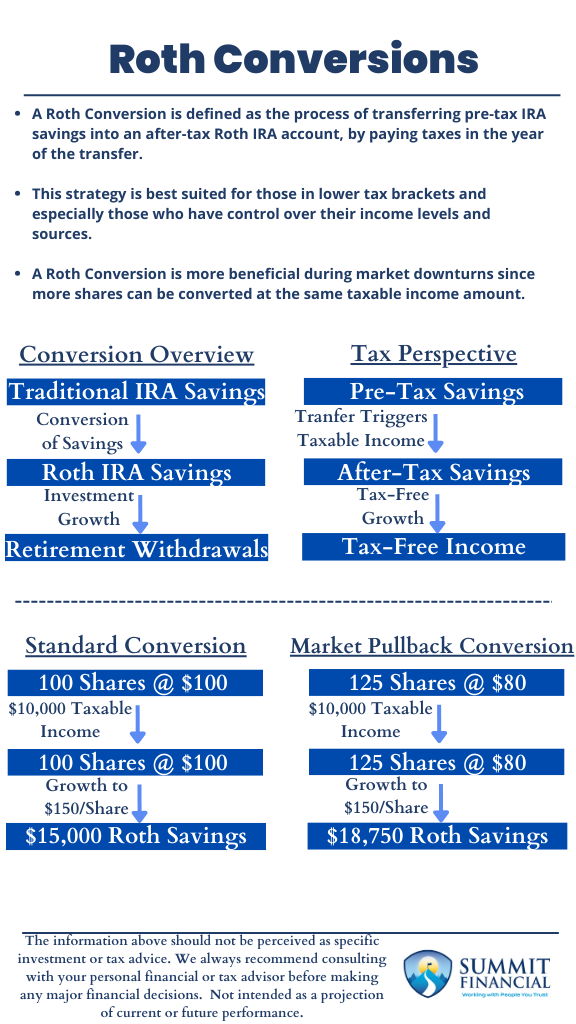Retirement income planning oftentimes includes a focus on limiting taxable consequences. A Traditional IRA or 401(k) provides pre-tax retirement savings, which trigger income taxes whenever a withdrawal is made. A Roth IRA provides after-tax savings that grow tax-free and are tax-free upon qualified withdrawals. This fundamental difference is why many investors seek Roth IRA savings even after they have retired.
Additionally, the Roth account could provide a tax-free inheritance if the funds are never used, and a Roth IRA does not require minimum distributions throughout retirement, so this type of account also allows for more flexibility.
What Is a Roth Conversion?
A Roth Conversion is the process of transferring pre-tax IRA savings into an after-tax Roth IRA account by paying taxes in the year of the transfer. This allows investors to reap the benefits of tax-free growth and flexibility moving forward.
How a Roth Conversion Works
The biggest downside to this strategy is that income taxes will be due on the amount transferred. Because of this, we only recommend Roth Conversions for those investors in lower tax brackets. If you are reporting $200,000 a year of income then converting another $50,000 does not provide much benefit since this conversion would be taxed at a very high bracket.
However, if you are earning less than $100,000 then this could be a great strategy to consider. Best case scenario is a retired individual with enough savings at the bank to fulfill all their income needs for the year. Retired individuals usually have control of their income levels and sources, so those who can live off their non-qualified savings are great candidates for a Roth Conversion.
With potentially $0 of income, you can convert up to your standard deduction tax-free, and you could also utilize the lowest tax rates of 10% and 12%. This tax rate should be compared to the expected tax bracket once RMDs begin at age 72, and the difference is a key benefit of performing the conversion.
Timing Roth Conversions with Social Security
Performing Roth Conversions before you begin Social Security will allow you to convert savings more tax-efficiently since the lower the income, the more you can utilize the lower brackets for the conversion.

Advantages of Roth IRA Conversions
Lastly, we wanted to touch on the benefit of performing a Roth Conversion during a market downturn. Remember, taxes are applicable only on the dollar amount converted. Let’s say an investor wanted to convert $100,000 or 100 shares at $1,000 each. If this investment just fell 10% then this conversion would only equate to $90,000. This means you could convert another $10,000 or approximately another 11 shares at $900 each.
Converting 111 shares compared to 100 shares is beneficial because you are converting a larger portion of your pre-tax savings. You have not triggered any additional income over your estimated $100,000, but you were able to convert more shares from the pre-tax account by utilizing the lowest tax brackets.
Roth IRA Conversion – Key Takeaways
- A Roth Conversion is defined as the process of transferring pre-tax IRA savings into an after-tax Roth IRA account, paying taxes in the year of the transfer.
- This strategy is best suited for those in lower tax brackets and especially those who have control over their income levels and sources.
- A Roth Conversion is more beneficial during market downturns since more shares can be converted at the same taxable income amount
Speak With a Trusted Advisor
If you have any questions about your investment portfolio, retirement planning, tax strategies, our 401(k) recommendation service, or other general questions, please give our office a call at (586) 226-2100. Please feel free to forward this commentary to a friend, family member, or co-worker. If you have had any changes to your income, job, family, health insurance, risk tolerance, or your overall financial situation, please give us a call so we can discuss it.
We hope you learned something today. If you have any feedback or suggestions, we would love to hear them.
Sincerely,
Zachary A. Bachner, CFP®
with contributions from Robert Wink, Kenneth Wink, James Wink and James Baldwin


